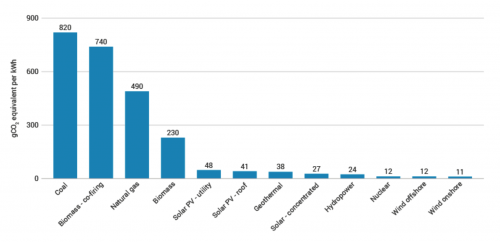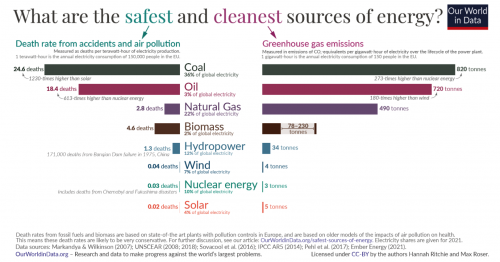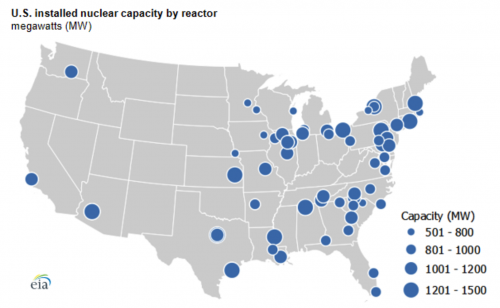Nuclear Power
Nuclear power background
Nuclear power encompasses technologies from 20th-century uranium-based fission (splitting atoms, which releases a lot of energy) all the way to the blue-sky promise of nuclear fusion (slamming two smaller atoms together to form a heavier one, which also creates a lot of energy). Virtually all of U.S. nuclear power today – 772 billion kilowatt-hours, or 18.2% of total U.S. generation – comes from large grid-connected plants of a type called light water reactors (LWR), which are fueled by uranium. Various LWR designs emerged from efforts to power U.S. military ships and submarines in the 1950s, and later were adapted for commercial power generation in the U.S. and around the world.
The map below shows where all 93 operating nuclear plants in the U.S. were located as of 2021.
Source: U.S. Energy Information Administration
Nuclear reactor concepts other than the LWR were researched decades ago but not widely adopted. However, they have drawn new interest as the shortcomings of 1960-vintage LWR technology become more evident. The urgency of tackling climate change has also informed a desire to rebalance old perceptions about nuclear energy with the need to increase the supply of firm power that does not emit greenhouse gases.
How nuclear power supports a clean and stable electric grid
Nuclear power plants do not emit greenhouse gases during their operation. Since its commercial deployment in the 1960s, nuclear power has generated over 30 million gigawatt-hours of carbon-free electricity in the U.S. Per the IPCC, the life-cycle carbon footprint of nuclear energy is lower than that of solar power and comparable to that of wind power (see chart below).

Image: World Nuclear Association
Nuclear-generated electricity can be considered clean firm power: clean because, once installed and operating, it generates no air pollutants or greenhouse gases; firm because it provides a steady, reliable source of power, which will be needed as dispatchable fossil generation like coal and gas are phased out. Another distinct advantage of nuclear power is the small land footprint, similar to that of other large central power plants but without the drawback of air pollution and greenhouse gas emissions. Compared to solar and wind, nuclear power requires only 1.3% and 0.3% as much land, respectively, for a given amount of electricity (see diagram below).
Source: C2ES
Issues with nuclear power
Nuclear power does come with some inherent impacts and risks related to radiation, but the human and environmental impacts are much lower than from fossil fuel combustion. The long-term health hazards of fossil fuels don’t generate spectacular news coverage like a nuclear accident, so it’s hard to dislodge the perception of nuclear energy as being uniquely dangerous that took root in the 1980s. However, despite three high-profile accidents – Three Mile Island in the U.S., Chernobyl in Ukraine, and Fukushima in Japan – total fatalities from the operation of all nuclear plants from 1950 to 2014 numbered less than 5,000, compared to 177,000 from hydro plants. Adjusted for total generation, nuclear’s safety record is actually comparable to wind and solar and deaths from air pollution caused by burning fossil fuels are hundreds of times higher. Radioactive emissions in the vicinity of coal plants are as much as 100 times those from nuclear plants.
A related issue is the large capital cost of a full-scale plant — as much as $15 billion per reactor — and a construction lead time as long as 20 years to get a new plant online. This is partly because many of the external costs associated with nuclear plant safety are internalized through stringent equipment codes, insurance, and fees. Even so, according to the International Energy Agency, nuclear power ranks with renewables and hydropower as one of the “least-cost options to ensure low-carbon electricity.”
Nuclear power generates radioactive waste from both plant operations and uranium mining. Some of this waste decays slowly and will remain radioactive for thousands of years. All of the spent fuel in the U.S. is currently stored at the plant sites under strict federal safety guidelines because the federal government has not approved sites for long-term geological storage.”
Uranium mining, which carries environmental and health risks, has caused significant harm in some local communities. It continues because the current LWR units need to refuel every 18-24 months. One solution is to reprocess and reuse the spent fuel, greatly reducing the net waste that must be safely stored, but for historical and political reasons, the technology was never fully developed in the U.S. And that is related to one more concern: nuclear weapon proliferation. While producing weapons-grade material from the low-enriched uranium used in LWRs is technically infeasible, reprocessing spent fuel to recover its considerable remaining energy also produces plutonium that could be used in a weapon. So there is a dilemma: one attractive solution to the waste and mining problem (reprocessing) raises the concern of weaponization.
Nuclear plants, like other thermal power plants, require cooling in order to condense the steam that spins the turbines and to cool the reactor core. About 74% of those plants cool with water from lakes, rivers, or the ocean and then discharge the warm water. This can have deleterious impacts on natural ecosystems and wildlife. One remedy for this is to switch to cooling towers as the other 26% of plants already use. In 2014, the EPA mandated that new nuclear plants use cooling towers, and provided a range of options for existing plants to protect aquatic life.
The desire to overcome these several barriers is leading public and private entities around the world to advance alternatives to traditional nuclear plant designs that address all of these concerns.
How much could nuclear power contribute to a clean and stable electric grid?
The Princeton Net-Zero Report offers five net-zero 2050 scenarios. While one scenario assumes nuclear power will be zeroed out due to a policy choice, the other four pathways predict that nuclear generation could range from 35% smaller to 210% larger. So nuclear power could account for between 0% and 29% of America’s total electricity generation in 2050, compared to 19% today.
The large range depends on a variety of factors. For example, how much total electricity is needed, how much does each sector of the economy electrify, how do future costs for nuclear power change, how is it affected by policy constraints, and how much can electricity demand be met by other technologies.
Other FAQs
What about Small Modular Reactors and Generation IV reactors?
There are serious efforts underway to develop small modular reactors (SMRs), which their advocates claim could be standardized and manufactured at much lower cost per gigawatt than traditional nuclear plants. It remains to be seen whether SMRs can achieve the promised economic advantages and safety improvements and survive the licensing gauntlet in the near term. But beyond efforts to simply “miniaturize” conventional LWR technology, a far greater ambition is the development of “Generation IV” reactors. Fundamentally different designs offer the promise to not only reduce high capital cost, but to mitigate concerns over radioactive waste, uranium mining, safety, and security. Among the concepts under consideration are molten salt reactors, very high temperature reactors, sodium-cooled fast reactors, and reactors based on thorium rather than uranium. There is some overlap among these concepts, but they are all aimed at mitigating the chief concerns that remain with legacy reactors.
Is nuclear power safe?
While there have been numerous nuclear incidents, its public safety record – due to exceedingly stringent safety requirements, design redundancy, and strict operator training — is hundreds of times better than fossil fuels.

It's worth noting that the external costs of fossil fuels from pollution and climate damage are still not reflected in their market prices, while the external costs associated with nuclear plant safety and waste storage are somewhat internalized through stringent equipment codes, insurance, and fees. In any industry, there is always a tradeoff between safety and cost, and it’s evident that public pressure to prioritize nuclear safety has been successful. And as noted above, there is increasing interest in Generation IV designs that may be intrinsically meltdown-proof, foreclosing any possibility of the kinds of accidents that have occurred so far.
Does CCL support nuclear power?
CCL supports energy that doesn't emit greenhouse gases. Nuclear fits that criteria. CCL supports policies like carbon fee and dividend that allow all low-carbon technologies, including nuclear, to be considered fairly.
What about fusion power?
Nuclear fusion is fundamentally different from nuclear fission, which powers all current nuclear power plants. Theoretically, fusion could unleash a tremendous reservoir of energy, but it’s proven immensely difficult to harness in a controllable way. Recent news of a “breakthrough” in fusion research does not actually signal the impending deployment of fusion power plants. There are fuel supply and engineering challenges that are still a long way from being resolved. Unlike nuclear fission, which is available right now, nuclear fusion is unlikely to meet these challenges in time to address the urgency of the climate crisis.

